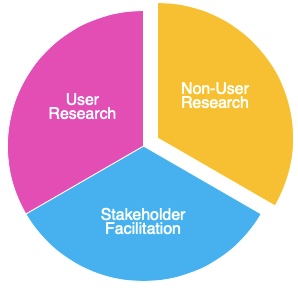Surprise! Not all UX research methods include users. There are other ways to inspect or understand the user experience without observing or talking to people.

Supplement your user research with the following.
9 Non-User UX Research Methods
Competitive Research
There are numerous ways to conduct independent competitive research: reading case studies (or interviews, articles, presentations, and other publicly available intel), creating a competitive matrix, auditing competitor experiences, or gathering best-in-class or innovative examples.
There is enormous value in scanning the competitive landscape as part of the design process—as your customers or users are likely to encounter these same experiences and establish expectations.
Secondary Research (Desk research)
In many industries, there are independent research firms and/or publications that regularly conduct industry or ad hoc studies. Typically, these research reports can cost hundreds or thousands of dollars to purchase—but can save organizations or design teams enormous ramp-up time. (And primary research budgets can instead be spent on gathering new insights.) Desk research also includes gathering data from any public source—not just paid sources.
Trend Analysis
Resources such as Google’s Keyword Planner, Google Trends, internal business data, government data (e.g., Bureau of Labor Statistics), and other industry data help UX researchers gain context on a broader timeline.
Weak Signal Scanning
What’s happening in the market or competitive landscape that industry analysts and journalists are not yet writing about? To uncover weak signals, search outside of mainstream sources. Over time, cluster weak signals into themes on a context map.
Service Safari (Experience audit)
To understand the user experience, it can be incredibly enlightening to go through the experience first-hand and then report back your findings. What is the process when applying for U.S. citizenship? What is the process when applying for a home mortgage? What is it like to find the right bus route from a busy street corner?
Heuristic Analysis
Also called an “expert review,” experienced UX researchers can evaluate designs for established best practices—and potentially ward off some (or many) common usability problems. For example, are error messages written in plain language (not internal codes)? Do all buttons and links use consistent colors and visual treatments (e.g., signifier)?
Accessibility Audit
Specialized researchers can detect some or many of the accessibility issues that can impede or harm the user experience for people who cannot see and/or hear. For example, do all videos include captioning or written transcripts? Does all text use colors and point sizes that are legible and high contrast?
Dogfooding
“Eating your own dog food” should not be taken literally. Instead, it means that employees use the company’s products or software (before launching to the public), and then provide their feedback.
Feedback Channel
A feedback channel is an internal intake tool for employees to log bugs and issues. Examples of feedback channels can include an online form on the company intranet, Slack, an email address, or project management software (e.g., Jira, GitHub).
See also: 28 User Research Methods
Related Articles
- Discovering Hidden Insights with Kano Analysis: A Case Study
- ESAT & CSAT: A Survey Alignment Love Story
- UX Research Toolbox: Anatomy of a Compelling Narrative for Your UX Research Reports
- Data Overload? How to Manage the Flow of CX Insights Effectively
- Bias-Free UX Research: Innovative Approaches to Mitigating Bias in the Research Process